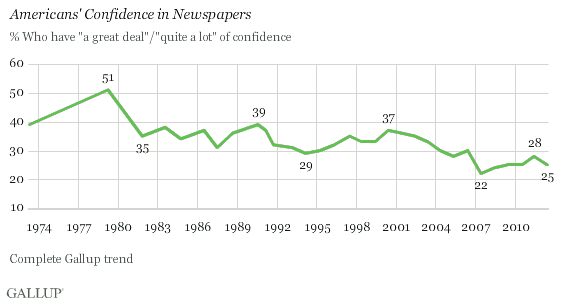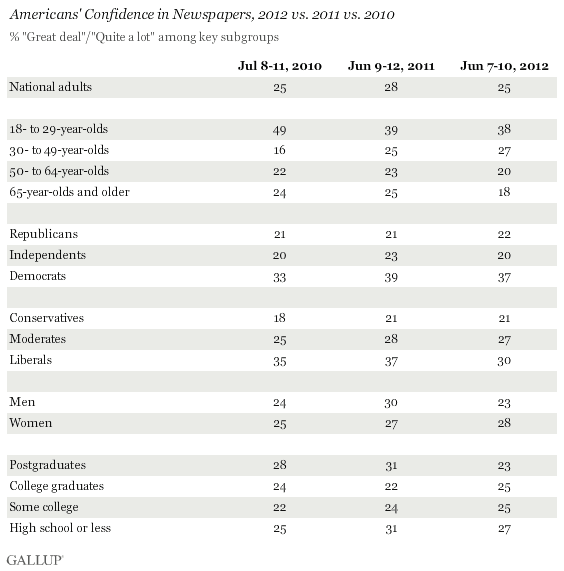WASHINGTON, D.C. -- Americans' confidence in television news is at a new low by one percentage point, with 21% of adults expressing a great deal or quite a lot of confidence in it. This marks a decline from 27% last year and from 46% when Gallup started tracking confidence in television news in 1993.

The findings are from Gallup's annual update on confidence in U.S. institutions, conducted June 7-10 this year. As such, the findings preceded the erroneous initial reports by cable-news networks CNN and Fox News regarding the U.S. Supreme Court's June 28 decision about the constitutionality of the U.S. healthcare law.
Among 16 U.S. institutions tested, television news ranks 11th, following newspapers in 10th place. The 25% of adults who express a great deal or quite a lot of confidence in newspapers is down slightly from 28% last year. Confidence in newspapers is now half of what it was at its peak of 51% in 1979.

This year's updates mark a setback from last year for both television news and newspapers, when Americans appeared to be regaining some confidence in these institutions, though they are more in line with 2007-2010 readings.
Liberals' and Moderates' Faith Plummets Below Conservatives'
Liberals and moderates lost so much confidence in television news this year -- 11 and 10 points, respectively -- that their views are now more akin to conservatives' views. This marks a turnaround from the pattern seen since 2009, in which liberals expressed more confidence than conservatives. Conservatives' views of television news were last similar to liberals' in June 2008, before the last presidential election. However, moderates are significantly less confident now than they were then, 20% vs. 28%.

The decline since last year in confidence in television news among liberals did not coincide with a similar decline among Democrats. Democrats this year are the most confident in the television news media among key subgroups. Interestingly, postgraduates, who tend to be Democrats, are now the least confident.

Many of the groups that lost confidence in television news also tended to lose confidence in newspapers, though to a lesser degree. These include liberals, older Americans, men, and postgraduates. Other groups budged only slightly.

Implications
It is not clear precisely why Americans soured so much on television news this year compared with last. Americans' negativity likely reflects the continuation of a broader trend that appeared to enjoy only a brief respite last year. Americans have grown more negative about the media in recent years, as they have about many other U.S. institutions and the direction of the country in general.
Still, confidence in television news could plummet further after the high-profile errors CNN and Fox News made in their coverage of the intensely anticipated Supreme Court healthcare law ruling that some have called a "Dewey defeats Truman" moment. CNN has promised an internal review, and its handling of the outcome of that review could help to bolster confidence. More broadly, these and other networks -- and the news media as a whole -- will have to renew their efforts to show Americans that they deserve a higher level of confidence than what they enjoy today.
Survey Methods
Results for this Gallup poll are based on telephone interviews conducted June 7-10, 2012, with a random sample of 1,004 adults, aged 18 and older, living in all 50 U.S. states and the District of Columbia.
For results based on the total sample of national adults, one can say with 95% confidence that the maximum margin of sampling error is ±4 percentage points.
Interviews are conducted with respondents on landline telephones and cellular phones, with interviews conducted in Spanish for respondents who are primarily Spanish-speaking. Each sample includes a minimum quota of 400 cell phone respondents and 600 landline respondents per 1,000 national adults, with additional minimum quotas among landline respondents by region. Landline telephone numbers are chosen at random among listed telephone numbers. Cell phone numbers are selected using random-digit-dial methods. Landline respondents are chosen at random within each household on the basis of which member had the most recent birthday.
Samples are weighted by gender, age, race, Hispanic ethnicity, education, region, adults in the household, and phone status (cell phone only/landline only/both, cell phone mostly, and having an unlisted landline number). Demographic weighting targets are based on the March 2011 Current Population Survey figures for the aged 18 and older non-institutionalized population living in U.S. telephone households. All reported margins of sampling error include the computed design effects for weighting and sample design.
In addition to sampling error, question wording and practical difficulties in conducting surveys can introduce error or bias into the findings of public opinion polls.
For more details on Gallup's polling methodology, visit www.gallup.com.
